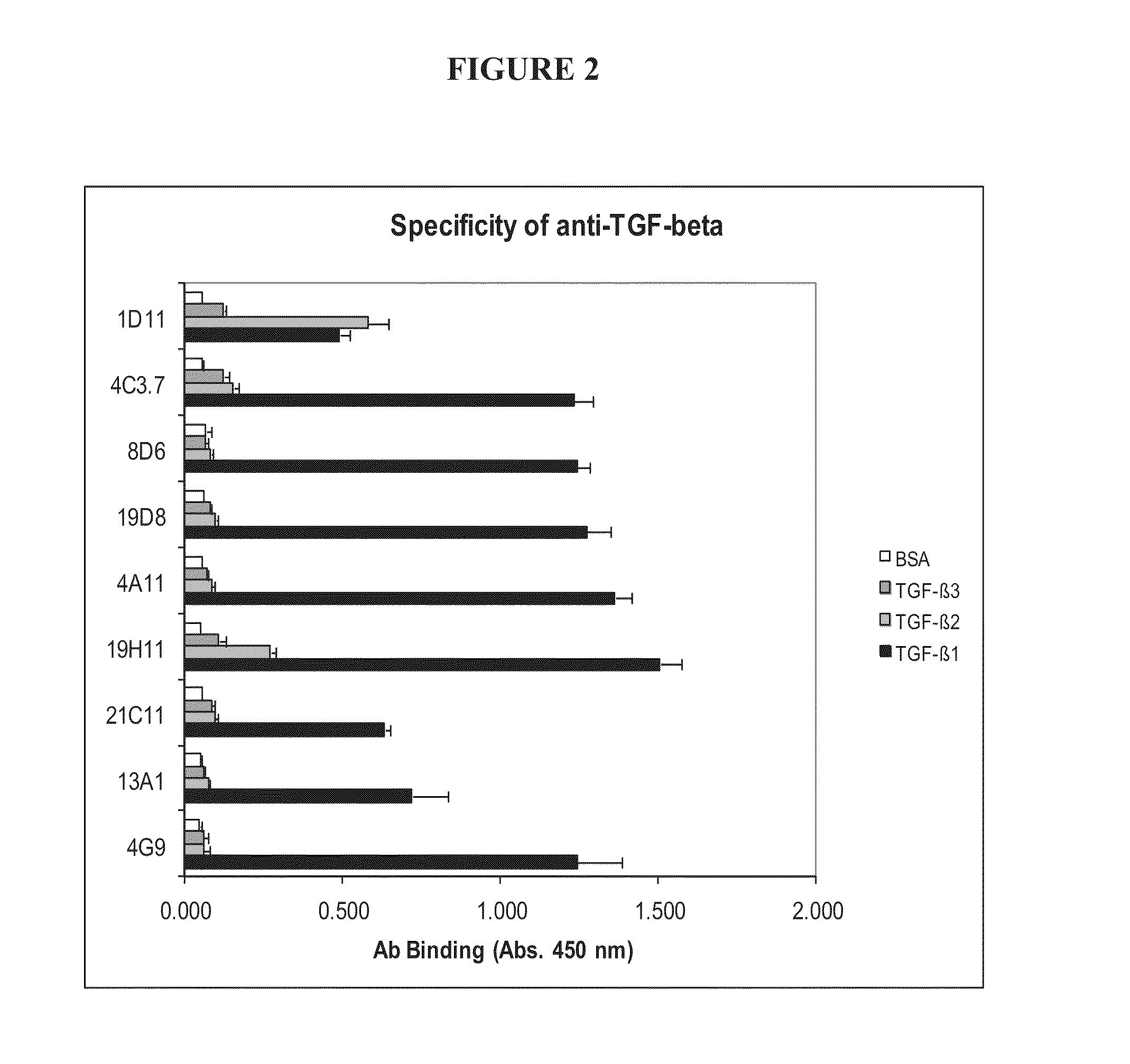Tgf-beta1 specific antibodies and methods and uses thereof
a specific antibody and antibody technology, applied in the field of specific binding members, can solve the problems of poor patient outcome and/or metastatic recurrence, and achieve the effects of enhancing antigen uptake, presentation and activation of antitumor immune responses, and promoting a more robust priming and activation
- Summary
- Abstract
- Description
- Claims
- Application Information
AI Technical Summary
Benefits of technology
Problems solved by technology
Method used
Image
Examples
example 1
Production of TGFbeta-1 Antibodies
[0187]TGF-beta antibodies were generated using a procedure in mice we have termed ‘auto-vaccination’. Auto-vaccination was successfully utilized to generate antibodies in mice against several proteins involved in the control of immune and inflammatory responses. In this procedure, large OVA multimers were made by treating ovalbumin (OVA) with glutaraldehyde to generate OVAglu and, after purifying the polymerized products by size exclusion chromatography, these OVA multimers are reacted with the target cytokine (in this instance TGF-beta1) before saturating remaining glutaraldehyde sites with PADRE peptide (aKXVAAWTLKAAC) (SEQ ID NO: 9) (Alexander, J. et al (1994) Immunity 1:751-761) to maximize immunogenicity. The efficacy of OVAglu in breaking tolerance against self-antigens was demonstrated by detection of specific antibodies to TGF-beta 1 by ELISA at serum dilutions of 104-106.
[0188]Antibodies to human TGF-beta-1 were prepared by subcutaneous vac...
example 2
Binding of Isolated TGF-Beta Antibodies is Specific for TGF-Beta-1
[0198]Isolated anti-TGF-beta antibodies generated by the protocol above were screened for binding ability to different TGF-beta isoforms. Maxisorb immunoplates were coated overnight at 4° C. with human TGF-beta-1, TGF-beta-2, or TGF-beta-3 (20-200 ng / ml in 50 mM glycine buffer, pH 9) or coated first with Neutravidin at 2 ug / ml in PBS, followed by biotinylated antigens (100 ng / ml). Contrary to 1D11.16 (also denoted as 1D11) mouse monoclonal anti-TGF-beta antibody, an established reference anti-TGF-β angtibody which recognizes TGF-β1, TGF-β2 and TGF-β3 (Dasch J R et al (1989) J Immunol 142:1536-1541), all the antibodies isolated, MTGF-beta-1.4C3.7, MTGF-beta1.8D6, MTGF-beta-1.19D8, MTGF-beta-1.4A11, MTGF-beta-1.19H11, MTGF-beta-1.21C11, MTGF-beta1.13A1 and MTGF-beta 1.4G9, bind only to TGF-beta-1 (FIG. 2). Detection of human TGF-beta-1 by sandwich ELISA is best achieved by using antibody 21C11, which is coated on an imm...
example 3
Neutralization of TGF-Beta-1 Activity
[0201]The TGF-β1 antibodies were tested for neutralizing activity by evaluating TGF-β1 mediated induction of the downstream gene PAI-1 in a luciferase assay in cells. MTGF-beta1.4C3.7, MTGF-beta1.4G9.1, MTGF-beta1.19D8 and MTGF-beta1.13A1 neutralize either human or mouse TGFbeta-1 activity. Antibodies MTGF-beta1.8D6, MTGF-beta1.4A11, MTGF-beta1.19H11 and MTGF-beta1.21C11 did not demonstrate TGF-beta1 activity neutralization in this assay (data not shown). Neutralization of TGF-beta-1 activity was demonstrated by evaluating loss of TGF-beta-mediated induction of downstream genes using methods described by Abe M et al. (Anal Biochem 1994 Feb. 1; 216(2):276-84). The expression of the PAI-1 gene was used to monitor TGF-beta activity.
[0202]Transfected mink lung epithelial cell line (TMLECs) were stably transfected with a truncated PAI-1 promoter fused to the firefly luciferase reporter gene. 500 pg / ml human TGFbeta-1 was incubated with serial serum di...
PUM
| Property | Measurement | Unit |
|---|---|---|
| Fraction | aaaaa | aaaaa |
| Current | aaaaa | aaaaa |
| Composition | aaaaa | aaaaa |
Abstract
Description
Claims
Application Information
 Login to View More
Login to View More - R&D
- Intellectual Property
- Life Sciences
- Materials
- Tech Scout
- Unparalleled Data Quality
- Higher Quality Content
- 60% Fewer Hallucinations
Browse by: Latest US Patents, China's latest patents, Technical Efficacy Thesaurus, Application Domain, Technology Topic, Popular Technical Reports.
© 2025 PatSnap. All rights reserved.Legal|Privacy policy|Modern Slavery Act Transparency Statement|Sitemap|About US| Contact US: help@patsnap.com



